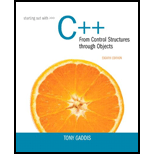
How many operands does each of the following types of operators require?
_______ Unary
_______ Binary
_______ Ternary
Explanation of Solution
Statement 1:
Unary operator:
Unary operators act upon one operand to create a new value.
The unary operators are as follows:
- Increment (++) or decrement (--) operators.
- Unary minus operator (-).
- Logical not operator (!).
Example:
Consider the following example:
a++;
The above example have one operand “a” and unary increment “++” operator; this operator is used to increment the “a” value by “1”.
Therefore, the unary operator requires only “one” operand.
Statement 2:
Binary operator:
Binary operators take two operands to create a new value.
The examples of binary operators are as follows:
- Addition (+).
- Subtraction (-).
- Division (/).
Example:
Consider the following example:
c = a + b;
The above example shows the addition of two operands “a” and “b” which is stored in “c” variable.
Therefore, the binary operator requires “two” operands.
Statement 3:
Ternary operator:
Ternary operators take three operands to create a new value. This ternary operator is also called as “conditional” operator. It is represented by the symbol, “?:”.
Example:
Consider the following example:
if (a > b)? cout << “a is greater”: cout << “b is lesser”;
The above example shows the comparison between two values, “a” and “b”. If “a” is greater, it will print the first statement, otherwise it will print the second statement.
Therefore, the ternary operator requires “three” operands.
Want to see more full solutions like this?
Chapter 2 Solutions
Starting Out with C++ from Control Structures to Objects (8th Edition)
Additional Engineering Textbook Solutions
Computer Science: An Overview (13th Edition) (What's New in Computer Science)
Starting Out With Visual Basic (8th Edition)
Elementary Surveying: An Introduction To Geomatics (15th Edition)
Introduction To Programming Using Visual Basic (11th Edition)
Java: An Introduction to Problem Solving and Programming (8th Edition)
Management Information Systems: Managing The Digital Firm (16th Edition)
- using r languagearrow_forwardI need help in explaining how I can demonstrate how the Laplace & Inverse transformations behaves in MATLAB transformation (ex: LIke in graph or something else)arrow_forwardYou have made the Web solution with Node.js. please let me know what problems and benefits I would experience while making the Web solution here, as compared to any other Web solution you have developed in the past. what problems and benefits/things to keep in mind as someone just learningarrow_forward
- PHP is the server-side scripting language. MySQL is used with PHP to store all the data. EXPLAIN in details how to install and run the PHP/MySQL on your computer. List the issues and challenges I may encounter while making this set-up? why I asked: I currently have issues logging into http://localhost/phpmyadmin/ and I tried using the command prompt in administrator to reset the password but I got the error LOCALHOST PORT not found.arrow_forwardHTML defines content, CSS defines layout, and JavaScript adds logic to the website on the client side. EXPLAIN IN DETAIL USING an example.arrow_forwardusing r languangearrow_forward
 Systems ArchitectureComputer ScienceISBN:9781305080195Author:Stephen D. BurdPublisher:Cengage Learning
Systems ArchitectureComputer ScienceISBN:9781305080195Author:Stephen D. BurdPublisher:Cengage Learning C++ for Engineers and ScientistsComputer ScienceISBN:9781133187844Author:Bronson, Gary J.Publisher:Course Technology PtrProgramming Logic & Design ComprehensiveComputer ScienceISBN:9781337669405Author:FARRELLPublisher:Cengage
C++ for Engineers and ScientistsComputer ScienceISBN:9781133187844Author:Bronson, Gary J.Publisher:Course Technology PtrProgramming Logic & Design ComprehensiveComputer ScienceISBN:9781337669405Author:FARRELLPublisher:Cengage Microsoft Visual C#Computer ScienceISBN:9781337102100Author:Joyce, Farrell.Publisher:Cengage Learning,
Microsoft Visual C#Computer ScienceISBN:9781337102100Author:Joyce, Farrell.Publisher:Cengage Learning, C++ Programming: From Problem Analysis to Program...Computer ScienceISBN:9781337102087Author:D. S. MalikPublisher:Cengage Learning
C++ Programming: From Problem Analysis to Program...Computer ScienceISBN:9781337102087Author:D. S. MalikPublisher:Cengage Learning LINUX+ AND LPIC-1 GDE.TO LINUX CERTIF.Computer ScienceISBN:9781337569798Author:ECKERTPublisher:CENGAGE L
LINUX+ AND LPIC-1 GDE.TO LINUX CERTIF.Computer ScienceISBN:9781337569798Author:ECKERTPublisher:CENGAGE L





